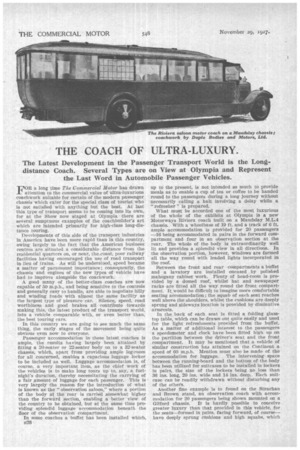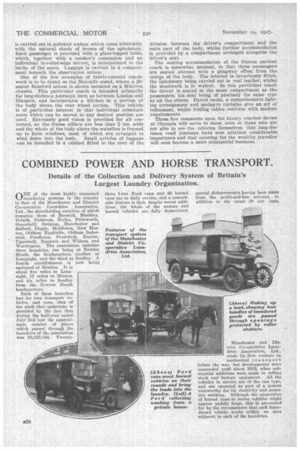THE COACH OF ULTRA-LUXURY.
Page 52

Page 53

Page 54

If you've noticed an error in this article please click here to report it so we can fix it.
The Latest Development in the Passenger Transport World is the Longdistance Coach. Several Types are on View at Olympia and Represent the Last Word in Automobile Passenger Vehicles.
TIOR a long time The Commercial Motor has drawn attention to the commercial value of ultra-luxurious coachwork suitable for certain of the modern passenger chassis which cater for the special class of tourist who is •not satisfied with anything but the best. At last this type of transport seems to be coming into its own, for at the Show now staged at Olympia there are several sumptuous examples of the coachbuilder's art which are intended primarily for high-class long-distance touring.
Developments of this side of the transport industries In America have been more rapid than in this country, owing largely to the fact that the American business centres are situated a considerable distance from the residential quarters on, or near, the„coast, poor railway facilities having encouraged the use of road transport in lieu of trains. As will be understood, speed became a matter of paramount importance; consequently, the chassis and engines of the new types of vehicle have had to improve alongside the coachwork.
A good many of the better-class coaches are now capable of 50 m.p.h., and being sensitive to the controls and generally easy to handle, are able to negotiate hilly and winding roads with almost the same facility as the largest type of pleasure car. Silence, speed, road worthiness and good brakes all contribute towards making this, the latest product of the transport world, into a vehicle comparable with, or even better than, the best touring cars.
In this country we are going to see much the same thing, the early stages of the movement being quite obvious even now to everyone.
Passenger accommodation in. these latest coaches is ample, the results having largely been attained by fitting a 20-seater or 22-seater body on to a 32-seater chassis, which, apart from providing ample leg-room for all concerned, enables a capacious luggage locker to be included as well. Luggage accommodation is, of course, a very important item, as the chief work of the vehicles is to make long tours up to, say, a fortnight's duration, thereby necessitating the carrying of a fair amount of luggage for each passenger. This is very largely the reason for the introduction of what is known as the' observation saloon," where a portion of the body at the .rear is carried somewhat higher than the forward section, enabling a better view of the country to be obtained, but at the same time providing splendid luggage accommodation beneath the floor of the observation compartment.
In some coaches a buffet has been installed which, n26 up to the present, is not intended so much to provide meals as to enable a cup of tea or coffee to be handed round to the passengers during a long journey without necessarily calling a halt involving a delay while a " refresher " is prepared. • What must be accorded one of the most luxurious of the whole of the exhibits at Olympia is a. new Motorways Riviera coach built on a Maudslay M.L.4 chassis. With a wheelbase of 19 ft. and a track of 6 ft. ample accommodation is provided for 20 passengers —16 being accommodated in pairs in the forward compartment and four in an observation section at the rear. The whole of the body is extraordinarily well lit and provides a splendid view in all directions. In the observation portion, however, windows are formed all the way round with leaded lights incorporated in the roof.
Between the front and rear compartments a buffet and a lavatory are installed encased by polished mahogany cabinet work. Plenty of head-room is provided by a domed roof, whilst hat and newspaper racks• are fitted all the way. round the front compartment. Itwould he difficult to imagine more comfortable seating accommodation; the squab of each seat reaches well above the shoulders, whilst the cushions are deeply sprung and sideways location is provided by diminutive armrests.
In the back of each seat is fitted a folding glasstop table, which can be drawn out quite easily and used for the light refreshments provided from the buffet. As a matter of additional interest to the passengers a speedometer and clock have been fitted high up on the partition between the driver's seat and the front compartment. It may be mentioned that a vehicle of similar construction has attained on the Continent a speed of 60 m.p.h. Mention must also be made of the accommodation for luggage. The interveningspace between the running-board and the bottom of the body has been utilized for suitcases to be installed in lockers in pairs, the size of the lockers being no less than 36 ins. long, 20 ins, wide and 14 ins. deep. Each suitcase can be readily withdrawn without disturbing any of the others.
Another fine example is to found on the Strachan and Brown stand, an observation coach with accommodation for 20 passengers being shown mounted on a Gifford chassis. It is hardly possible to conceive greater luxury than that provided in this vehicle, for the seats—formed in pairs, facing forward, of course— have deeply sprung cushions and high squabs, which are also sprung. The forward compartment has accommodation for eight passengers, and the rear compartment, which is raised somewhat, provides accommodation for 12 passengers.
In this body luggage accommodation is provided beneath the floor of the rear compartment, whilst at the rear end of the vehicle a lavatory is installed. The whole of the interior woodwork is in inlaid mahogany, and the upholstery is in real antique leather, a combination giving an appearance equivalent to that of a ship's cabin. This impression, incidentally, is still further increased by the Lincrustadecorated roof, incorporating ventilators and neat interior lighting arrangements.
An observation saloon, designated a parlour coach, is exhibited by Short Brothers, and is mounted on an Associated Daimler chassis. This coach, too, is divided into two compartments, the forward one of Which provides accommodation for 14 passengers to be seated in pairs, whilst the rear compartment, with loose individual seats, has accommodation for six passengers. The seats can be moved to face in any direction. This compartment also contains a folding table, fitted in the centre of the compartment.
Each seat in the forward compartment is provided with a table, likewise a magazine pocket, both of which are formed in the back of each seat. The foremost seat of each row is provided with a detachable table fitted to the side of the body. So far as equipment is concerned, it would be difficult to mention any unprovided accessory. For instance, the front corn
partment has an imitation electric fire, providing an atmosphere of coziness unattainable by any other means, but -which is, in reality, heated by the exhaust gases from the engine. Interior lights attached to each of the frame pillars are operated by individual switches, whilst three fans are fitted at various points to ensure adequate ventilation.
In the intervening space between the two compartments a kitchen and buffet are installed at one side of the centre gangway, and a toilet saloon on the other side. Figured moquette upholstery, combined with a very tasteful woodwork scheme, provide an air of luxury which can only be likened to that of a boudoir.
Few coaches could vie successfully with the observation parlour coach which Is shown on the Hall-Lewis stand. The body provides accommodation for 22 passengers, 12 of whom are accommodated in a raised observation compartment at the rear. A low-loading Bristol chassis enables the floor of the forward compartment to be particularly low, which has the effect of bringing the floor of the observation portion also reasonably low. The interior is sumptuously equipped, the seats being upholstered in furniture hide, and the squabs, which give adequate support to the shoulders, being soft and placed at just the right angle to maintain comfort on a long run. The interior woodwork
is carried out in polished walnut which tones admirably with the natural shade of brownof the upholstery. Each passenger is provided with a glass-topped table, which, together with a smoker's companion and an individual bevelled-edge mirror, is incorporated in the backs of the seats. Luggage is carried in a compartment beneath the observation saloon.
One of the few examples of fabric-covered coachwork is to be found on the Metcalfe stand, where a 20seater Romford saloon is shown mounted on a Minerva chassis. This particular coach is intended primarily for long-distance journeys, such as between London and Glasgow, and incorporates a kitchen in a portion of the body above the rear wheel arches. This vehicle is of _particular interest in that individual armchair seats which can be moved to any desired position are used. Extremely good vision is provided for ,all concerned, as the frame pillars are less than 2 ins. wide and the whole of the body above the waistline is framed up to form windows, most of which are arranged to wind down into the body. Small articles of luggage can be installed in a cabinet fitted to the rear of the division between the driver's compartment and the main part of the body, whilst further accommodation is provided by a compartment arranged alongside the driver's seat.
The seating accommodation of the Dennis parlour coach is somewhat unusual, in that three passengers are seated abreast with a gangway offset from the centp of the body. The interior is luxuriously fitted, the upholstery being carried out in real leather, whilst the woodwork is in walnut. In this particular coach the driver is seated in the same compartment as the passengers, his seat being of precisely the same type as all the others. Parcel racks, a comprehensive lighting arrangement and spring-to curtains give an air or refinement, whilst folding tables conform with modern requirements.
These few comments upon the luxury coaches shown at Olympia will serve to show, even to those who are not able to see the vehicles themselves, that long-distance road journeys have now attained considerable importance and that catering for the wealthy traveller will soon become a more substantial business.




















































































































